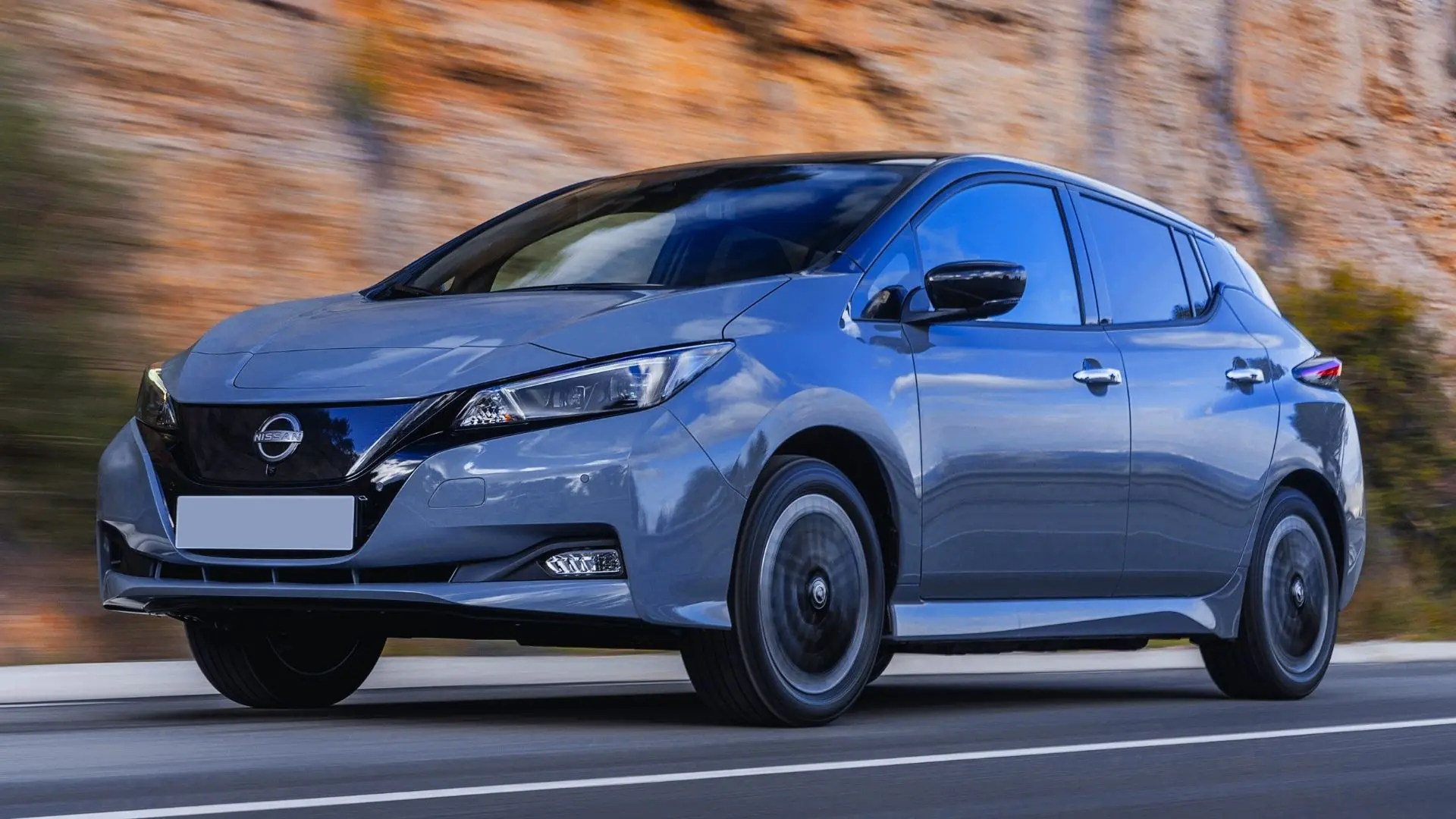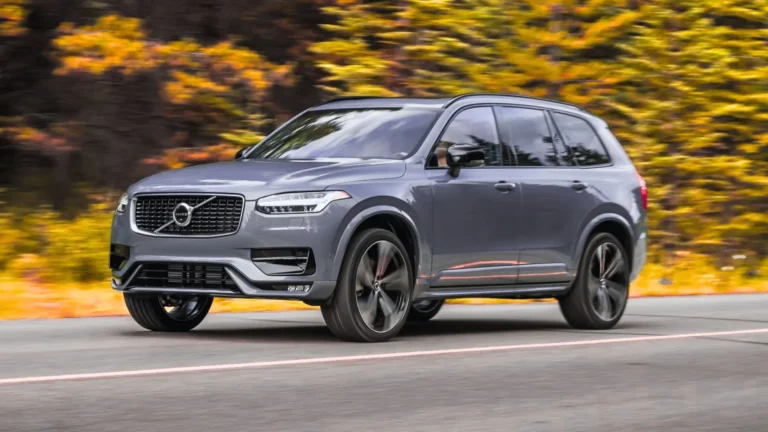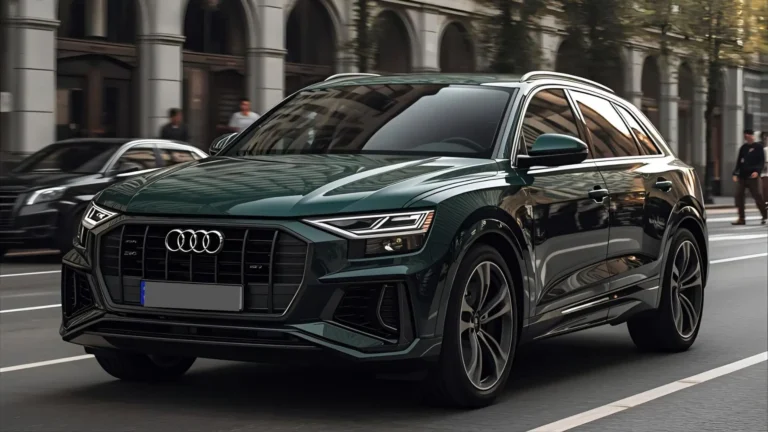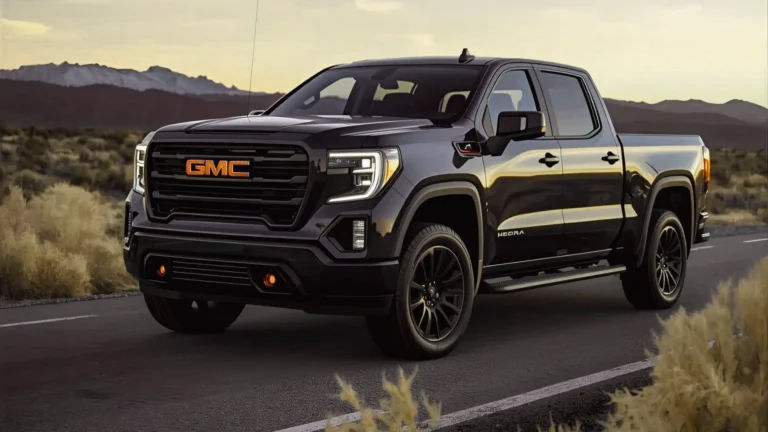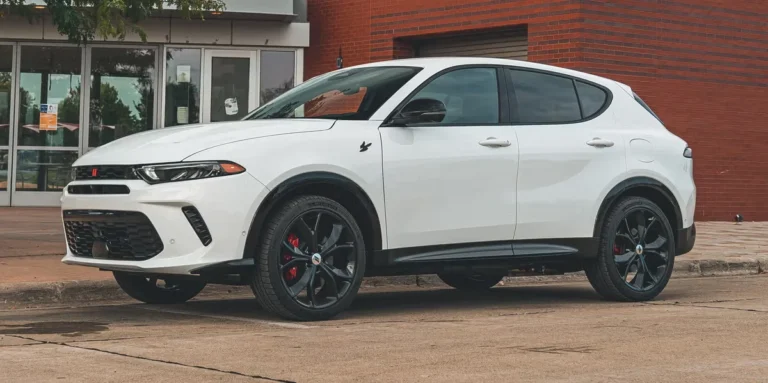Nissan Leaf Review: Electric Car Specs, Pricing, Safety Features
The Nissan Leaf changed how people see electric cars. It came out in 2010. Since then, it has become one of the most popular electric vehicles worldwide. This car runs only on electricity. You don’t need gasoline at all. The Nissan Leaf is perfect for daily driving. It saves you money on fuel. It also helps the environment. This guide will tell you everything about this amazing electric car.
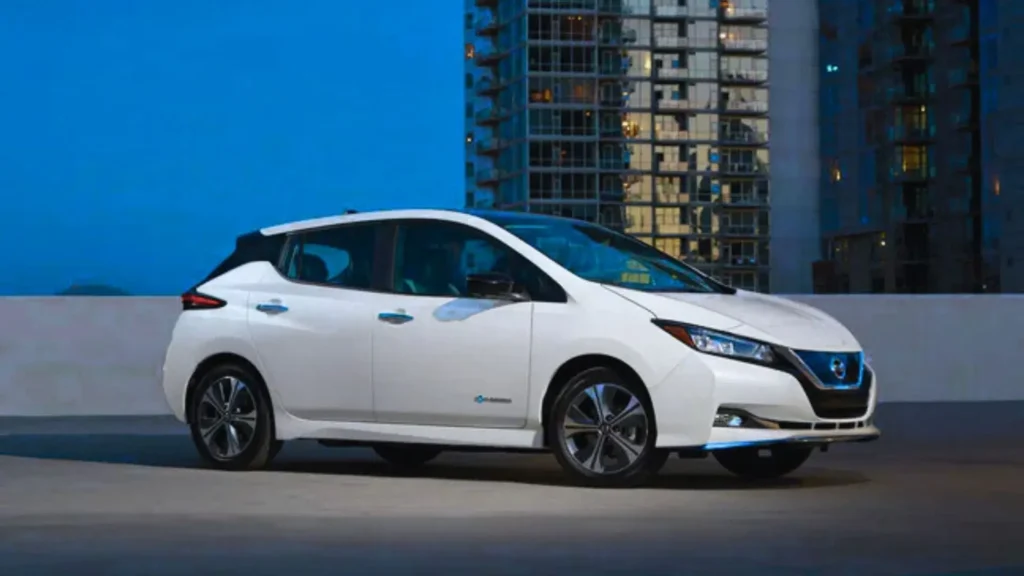
What Makes the Nissan Leaf Special?
The Nissan Leaf is a five-seat electric hatchback. It looks like a regular car from the outside. But under the hood, everything is different. There is no engine. Instead, it has an electric motor. The motor gets power from a battery pack. This battery sits under the floor. It keeps the car balanced and stable.
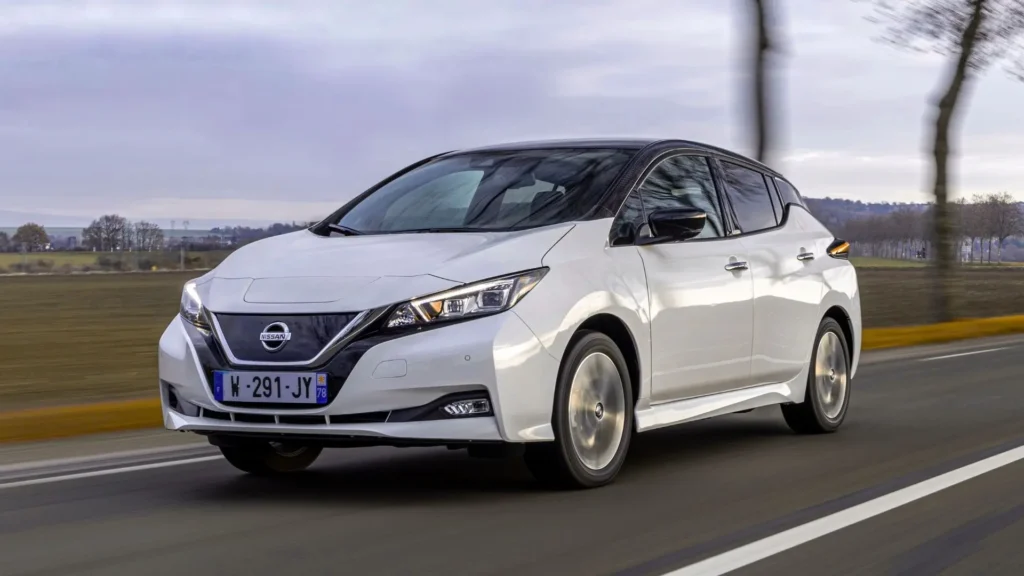
Nissan built this car for everyday people. They wanted electric cars to be normal. The Nissan Leaf proved that electric cars can work for regular families. You can drive it to work. You can take kids to school and can go for shopping. It does everything a normal car does.
Battery and Power Details
Standard Battery Model
The basic Nissan Leaf has a 40 kWh battery. This battery gives you good range for daily use. Here are the main power details:
- Motor Power: 147 horsepower
- Torque: 236 pound-feet
- Driving Range: Up to 149 miles per charge
- Top Speed: 90 miles per hour
- Zero to 60 mph: Takes about 7.4 seconds
Larger Battery Model
The Nissan Leaf Plus has a bigger 62 kWh battery. It gives you more range and power:
- Motor Power: 214 horsepower
- Torque: 250 pound-feet
- Driving Range: Up to 215 miles per charge
- Top Speed: 98 miles per hour
- Zero to 60 mph: Takes about 6.8 seconds
Both models give you instant power. Electric motors work differently than gas engines. They deliver all their power right away. This makes the car feel quick and responsive.
Charging Your Nissan Leaf
Home Charging Options
You can charge your Nissan Leaf at home. There are two main ways to do this.
Level 1 Charging uses a regular wall outlet. It works with 120 volts. This is the slowest way to charge. It takes about 24 hours to fully charge the battery. Most people use this as a backup option.
Level 2 Charging uses a 240-volt outlet. This is much faster. You need to install a special charging station. The 40 kWh battery charges in about 8 hours. The 62 kWh battery takes around 11.5 hours. Most owners charge overnight at home.
Public Fast Charging
The Nissan Leaf uses CHAdeMO fast charging. You can find these chargers at public stations. Fast charging is much quicker than home charging:
- Charges from 20% to 80% in 40 to 60 minutes
- Perfect for road trips or quick top-ups
- Available at shopping centers and highway stops
- CHAdeMO network has thousands of locations
Size and Space
Outside Measurements
The Nissan Leaf has a compact size. It fits well in city parking spots. Here are the exact measurements:
- Length: 176.4 inches
- Width: 70.5 inches
- Height: 61.4 inches
- Wheelbase: 106.3 inches
- Ground Clearance: 6.3 inches
- Weight: 3,509 to 3,831 pounds
Inside Space
The cabin offers good room for passengers. Five people can sit comfortably. The front seats have plenty of space. Tall drivers will feel comfortable. Back seat passengers have decent legroom.
Cargo Space is practical for daily needs:
- 23.6 cubic feet with seats up
- 30 cubic feet with rear seats folded
- Enough room for groceries and luggage
- Flat loading floor makes packing easy
Driving Features That Stand Out
E-Pedal Technology
The e-Pedal is a special feature. It changes how you drive. You can use just one pedal for most driving. Press down to speed up. Lift your foot to slow down. The car slows down smoothly. It can even come to a complete stop. This feature does two important things:
- Captures energy when slowing down.
- Charges the battery while driving.
- Makes city driving easier.
- Reduces brake wear significantly.
You can turn e-Pedal on or off. Some drivers love it. Others prefer traditional driving. The choice is yours.
ProPILOT Assist System
Higher trim levels include ProPILOT Assist. This system helps you drive on highways. It makes long trips less tiring:
- Keeps the car centered in your lane.
- Maintains distance from cars ahead.
- Adjusts speed automatically in traffic.
- Helps with steering on straight roads.
- Reduces driver fatigue on long drives.
You must keep your hands on the wheel. The system is an assistant, not a replacement for you.
Technology and Connectivity
Nissan Connect EV App
Your smartphone becomes a remote control. The NissanConnect EV app lets you manage your car from anywhere:
- Check battery level from your phone.
- Start or stop charging remotely.
- Set charging schedules for cheaper electricity.
- Pre-heat or pre-cool the cabin.
- Find nearby charging stations.
- Track your driving efficiency
- Plan routes with charging stops.
The app works on iPhone and Android. It connects through cellular networks. You don’t need to be near the car.
Inside Screen and Controls
The dashboard has an 8-inch touchscreen. It controls most car functions. The screen is easy to read. The menus are simple to navigate:
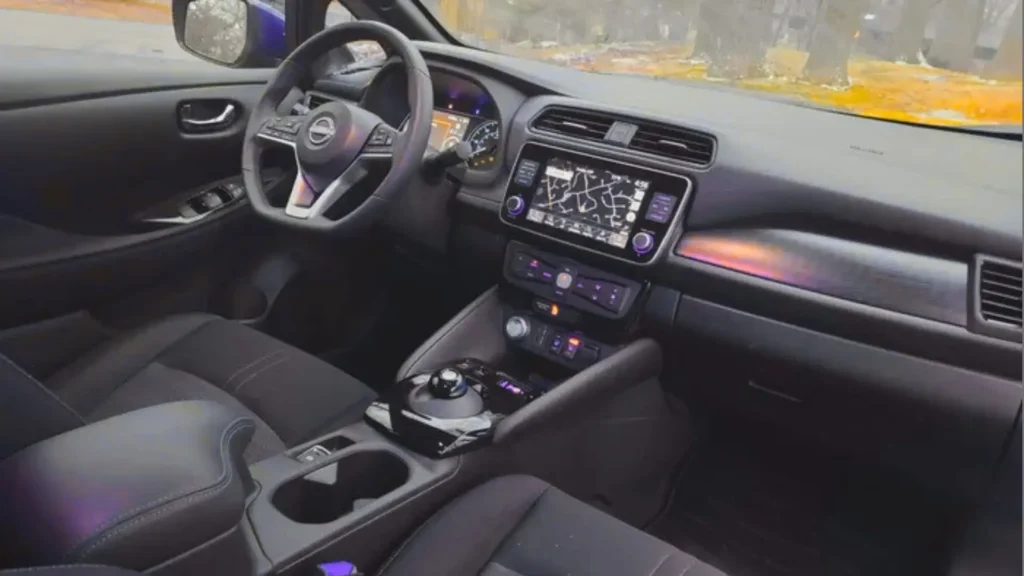
- Apple CarPlay works perfectly.
- Android Auto connects smoothly.
- Voice commands understand you clearly.
- Navigation shows charging stations.
- Energy usage displays in real-time.
Behind the steering wheel sits a digital display. It shows your speed, battery level, and range. The graphics are clear and colorful. Everything is easy to read while driving.
Safety Equipment
Standard Safety Features
Every Nissan Leaf includes important safety technology. These systems watch the road for you:
Automatic Emergency Braking can stop the car automatically. It sees cars and people ahead. If you don’t brake in time, it will brake for you. This helps prevent crashes.
Blind Spot Warning watches the lanes beside you. Lights appear in your mirrors when cars are there. This helps you change lanes safely.
Rear Cross Traffic Alert helps when backing up. It warns you about cars coming from the sides. This is useful in parking lots.
Lane Departure Warning keeps you in your lane. If you drift without signaling, it alerts you. Some models will gently steer you back.
High Beam Assist manages your headlights. It switches between high and low beams automatically. It detects other cars and adjusts the lights.
Crash Protection
The Nissan Leaf body is strong. High-strength steel protects passengers. The battery pack sits in a protected area. Special structures surround it. In a crash, the battery stays safe.
Safety organizations gave the Nissan Leaf good ratings. It performed well in crash tests. Side airbags and curtain airbags protect everyone inside.
Cost and Value
Purchase Price
The Nissan Leaf costs less than many electric cars. The base model starts around $29,280 to $30,000. Higher trims with more features cost more. The Leaf Plus with the bigger battery adds about $6,000 to $8,000.
Federal tax credits can lower the price. You might get up to $7,500 back. Many states offer additional rebates. Some power companies give money back too. Check what’s available in your area.
Daily Running Costs
Electricity costs much less than gasoline. Charging at home is cheapest. Most people spend $30 to $50 per month on electricity. That’s about $400 to $600 per year. Compare that to $1,500 or more for gasoline.
Maintenance costs are lower because electric cars are simpler:
- No oil changes needed.
- No transmission fluid to replace.
- Fewer brake pad replacements.
- No spark plugs or air filters.
- No exhaust system repairs.
You still need to rotate tires and check brakes. But overall maintenance is much cheaper than gas cars.
How It Drives
City Driving
The Nissan Leaf excels in cities. It’s quiet and smooth. The instant power helps you merge into traffic. Parking is easy because the car is compact. The turning circle is small. You can make tight turns easily.
Regenerative braking works great in stop-and-go traffic. The e-Pedal makes driving in traffic less tiring. You rarely need the brake pedal. The car slows itself when you lift off the accelerator.
Highway Performance
On highways, the Nissan Leaf drives comfortably. It has enough power to pass other cars. Highway driving uses more battery than city driving. Wind resistance affects electric cars more. Plan your trips and know your range.
The ride is smooth and quiet. You hear some wind noise at high speeds. But it’s still quieter than gas cars. The low center of gravity keeps the car stable. It doesn’t lean much in corners.
Weather and Climate
Hot Weather Performance
Heat affects the battery range slightly. The air conditioning uses battery power. But the Nissan Leaf handles heat reasonably well. Park in shade when possible. Pre-cool the cabin while plugged in.
Newer models manage heat better than old ones. The battery stays within safe temperatures. You won’t see huge range drops in summer.
Cold Weather Considerations
Cold weather reduces battery range more. Batteries work less efficiently when cold. Heating the cabin also uses significant power. You might lose 20% to 30% of range in very cold weather.
Here are tips for winter driving:
- Pre-heat the car while charging.
- Use seat heaters instead of cabin heat.
- Park in a garage when possible.
- Keep the battery charged above 20%.
- Plan for shorter range in freezing weather.
The heat pump in newer models helps. It heats the cabin more efficiently. This saves battery power in cold weather.
Comparing to Other Electric Cars
Against Tesla Models
Tesla cars cost significantly more. They offer longer range and faster charging. But the Nissan Leaf costs $10,000 to $20,000 less. It’s more affordable for average buyers. Tesla has a better charging network. But the Nissan Leaf is easier to buy and service.
Against Chevrolet Bolt
The Chevrolet Bolt offers similar range. It costs about the same. Both are good choices. The Nissan Leaf has better driver assistance features. The Bolt has a different body style. Choose based on which you prefer.
Against Hyundai Kona Electric
The Kona Electric has longer range. It can go up to 258 miles. But it costs more than the base Nissan Leaf. The Kona has a sportier feel. The Nissan Leaf has more interior space.
Battery Life and Warranty
How Long Batteries Last
Nissan Leaf batteries last many years. Most batteries keep 70% to 80% capacity after 10 years. This is normal for electric car batteries. The battery slowly loses range over time. But it happens gradually.
Newer batteries last longer than old ones. Nissan improved the battery chemistry. They also improved cooling and management systems. Taking care of your battery helps it last longer:
- Avoid charging to 100% every day.
- Don’t let it drop below 20% often.
- Use fast charging only when needed.
- Park in moderate temperatures when possible.
Warranty Coverage
Nissan backs the battery with a strong warranty:
- 8 years or 100,000 miles coverage.
- Replaces battery if capacity drops too much.
- Covers battery defects and failures.
- Gives peace of mind to buyers.
The rest of the car has a standard 3-year/36,000-mile warranty. Powertrain coverage lasts 5 years or 60,000 miles.
Environmental Benefits
Zero Emissions While Driving
The Nissan Leaf produces no exhaust. There’s no tailpipe at all. This means no harmful gases while driving. Cities with many electric cars have cleaner air. You help reduce pollution in your neighborhood.
Overall Environmental Impact
The total environmental benefit depends on your electricity source. Clean energy makes electric cars even greener. Solar, wind, and hydro power are best. But even with coal power, electric cars usually produce less pollution than gas cars.
Manufacturing the battery does create emissions. But over the car’s lifetime, it produces far less pollution than a gas car. Studies show electric cars are cleaner after about two years of driving.
Battery Recycling
Old Nissan Leaf batteries don’t go to waste. Many get a second life in home energy storage. They store solar power for houses. Eventually, the materials get recycled. Nissan works with recycling companies. They recover valuable materials from old batteries.
Trim Levels and Options
Nissan Leaf S
This is the base model. It includes everything you need:
- 40 kWh battery
- 147 horsepower motor.
- Basic infotainment system.
- Standard safety features.
- Cloth seats.
- Manual seat adjustment.
Nissan Leaf SV
The SV adds comfort and convenience:
- Larger touchscreen.
- Better sound system.
- ProPILOT Assist available.
- Leather-wrapped steering wheel.
- Quick Charge port package.
- More USB ports.
Nissan Leaf Plus Models
The Plus versions have the 62 kWh battery. They come in SV Plus and SL Plus. You get more range and power. Everything else matches the regular SV or SL.
Real Owner Experiences
Many Nissan Leaf owners love their cars. They save money on fuel and maintenance. The quiet ride is a favorite feature. Most use their cars for commuting and errands. They rarely worry about range.
Some owners wish for longer range. They want to take more road trips. Others wish for faster charging. But most are very happy with their purchase. They appreciate the simplicity and low costs.
First-time electric car buyers often say it’s easier than expected. Charging at home becomes routine. They forget about gas stations. The driving experience feels modern and smooth.
Conclusion
The Nissan Leaf makes electric driving accessible to everyone. It offers practical range for daily commuting and errands. The car saves you money on fuel and maintenance costs. Advanced safety features protect you and your family. Charging at home is convenient and simple. The smooth, quiet ride makes every trip enjoyable. Battery technology proves reliable over many years. This electric car works perfectly for regular families who want to save money while helping the environment.

